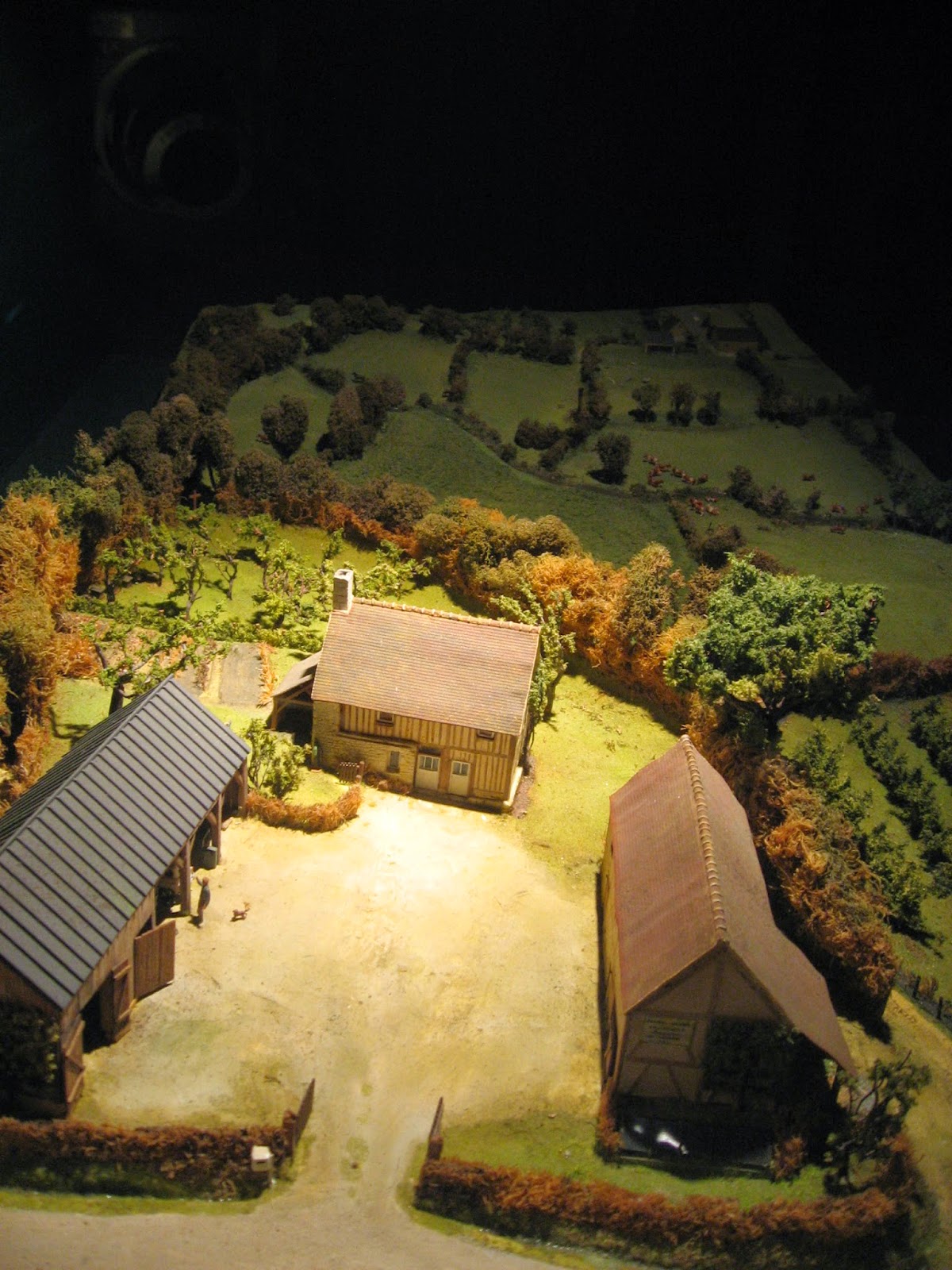What a great visit to the "Maison de la Pomme et de la Poire" in Barenton. We spent a couple of hours touring the museum and then walking through the orchard, learning how apple cider and "poiré", (a pear cider) are made.
Apples have been around at least since Adam and Eve... and have always been a source of temptation.
This model of an old farmstead shows how, many years ago, apple and pear trees grew on the land. They were used for desserts, and one in particular sounded so good: étouffée. Regular bread dough, with just a small amount of added water, was wrapped around crushed apples. The whole thing would then be put in the embers of the baker's oven fire. Because it was completely covered, it would "choke" (which is what étouffée means) until fully baked. I want to find a restaurant that serves that!
Apples were also used to make cider. In this region of Normandy, the locals have taken to adding pears to the apples to add taste and cut the acidity. The "poiré" is mild, not too sweet, and very tasty. It is effervescent and the cork "pops" when it is opened, just like champagne.
A chart showing what the trees look like during each season of the year.
Bees and wind are needed for pollination.
A great little invention to pick up the apples that have fallen to the ground. The apples are not picked from the tree because bruising is not an issue. The apples are to be made in purées, jams and cider.
Baskets for pears.
Pears cannot be kept long and must be processed as soon as they're picked.
A display of how a thatched roof is made.
Karl identifying new little pears.
Pear trees are huge, much bigger than apple trees.
Pear trees are grafted to other pear trees to keep the genes strong.
The air is sweet and refreshing, very floral.
Bee hives used for pollination.
This is a loaded apple tree.
How long does a pear tree live?
Around here, about 300 years: 100 to grow, 100 to produce fruit, and 100 to die.
What's left of a little burrowing owl nest.
Such a wonderful walk through the orchard.
When horses were still used to process apples to a pulp, this stone crusher was the best thing going! There are so many similarities with the olive press that we visited last year.

Various stages of the cider being pressed and eventually put in barrels for fermentation.
The "grand-daddy" of the juicer I saw at the Vide Grenier!
Originally, it was the apothecary (pharmacy) that dispensed cider for medicinal purposes. Once the State found out it was so popular, and so lucrative, guess who took over...
Tasting is always the fun part.
This juicer is about the size of the one I saw at the Vide Grenier. Perhaps I should have bought it after all!
Karl wants to replace our water cooler with this contraption. He would dispense cider, beer, wine - depending on the season and our guests' tastes!
This was a museum and orchard, not a production house for cider. They did sell local brands of apple and pear products, so we bought a bottle of poiré, two varieties of Calvados, and two jars of jam: Rhubarb Calvados and Pomme-Oranges.
***
All that fresh air gave us a hearty appetite for dinner. Again, we found the best little restaurant in Lonlay l'Abbaye, between Barenton and Domfront.
 |
| Le Relais de l'Abbaye |
The amuse-bouche was a cheese feuilleté and a tuna toast, one each. We of course indulged in some poiré.
I especially liked the presentation on the table, with a few sprigs of lavender put in a little swing top bottle clamp, the same one that poiré comes in, but in a different size.
We both had the Camembert melted on toast over a salad. Again, the presentation with the half cherry tomatoes and chives was so pretty! That salad was awesome...
The ever present bread. These were 4 buns rather than slices of baguette.
I had the shrimp "vol-au-vent" with loads of dill, along with rice, baked tomato and a parcel of green beans tied with a strip of leek.
Karl had the pork tenderloin in old-fashioned grainy mustard with matchstick fries and the same beans and tomato I had.
We finished dinner with an incredibly delicious Tiramisu. Might the chef have some Italian roots?
Mmmmmm.
***
 |
| The Abbey |
 |
| Fountain in front of Abbey |
 |
| Front door to Abbey |
 |
| Abbey interior |
 |
| Back of Abbey |

















































Hi, again. Your choice of activities is simply splendid. This one is a favourite for me. 300-year-old pear trees, my goodness. In our Okanagan, many of the new trees planted are slated for 7-year life spans. They bear fruit almost immediately, are engineered to never grow tall for ease of picking, and are discarded within a decade. And yet the small neighbourhood orchard next door to my parents' house still has fruit and hazelnut and walnut trees that were 65-years-old and still bearing. Big sigh! Love Calvados.
ReplyDelete